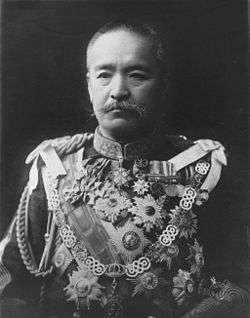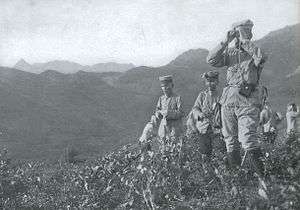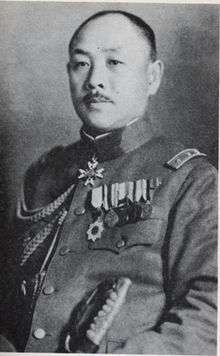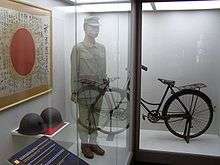Uniforms of the Imperial Japanese Army
.svg.png)
| ||||||||||||||||||||
Imperial Japanese Army Uniforms tended to reflect the uniforms of those countries who were the principal advisors to the Imperial Japanese Army at the time.
1867 Blue uniform
The initial uniform colour was dark blue, following the contemporary French style and resembling that of the Union Army of the American Civil War.

1886 Blue uniform
Resembling the Imperial German Army M1842/M1856 dunkelblau uniform, the dark blue single-breasted tunic had a low standing collar and no pockets. It was worn with matching straight trousers and a kepi (red for Imperial Guard) on which was worn a brass five point star. After the Franco-Prussian War the kepi was replaced with a flat topped peaked cap and the tunic collar became higher. Pockets were added to officers' tunics late in its issue.

Infantry uniforms had red facings on tunic collars, shoulder straps and trouser stripes. Line infantry had yellow bands and piping on their caps while the infantry of the Imperial Guard were distinguished by red. Trouser seams for both branches of the infantry had wide red stripes. Artillery had yellow facings on their dark blue uniforms. The branch colour for engineers was dark brown, green for medical and light blue for transport units. Finance, administration and other support services had white facings.
A dark blue shako (red for Imperial Guard units) with a short white plume was worn for full dress. The ordinary duty and active service headdress was however a form of peaked cap with a narrow crown, somewhat resembling the French kepi of the period.
A lightweight white cotton uniform was used for fatigue duties and tropical wear. In hot weather white trousers and cap covers were worn with the dark blue tunics. White canvas leggings were worn by non-mounted personnel with both white and blue uniforms until 1906.
Senior officers could wear a longer, double-breasted version of the tunic in full dress. Other features included elaborate Austrian knots (gold braiding on the cuffs according to rank), waist sashes, gold shoulder cords and plumes on the dress kepi. For ordinary duties and active service officers of all ranks wore dark blue dolmans braided in black. In 1904 this was replaced by a dark blue tunic of simpler pattern.
Cavalry regiments wore a short attila jacket with transverse hussar style braiding in yellow (red for the cavalry of the Imperial Guard). Breeches were red. The cavalry branch colour was green and in 1905 this colour appeared on both collars and breeches stripes. As with the other branches of the Imperial Guard, the cavalry were distinguished by red bands and piping on their service caps. Red trousers were also worn by army bands and by the Military Police (Kempeitai).
The dark blue uniform adopted under the 1886 Regulations was retained with only minor modifications until 1905. As such it was worn during the early months of the Russo-Japanese War. A khaki summer uniform had been introduced shortly before the outbreak of war and this became general issue for front line infantry during June–August 1904. Cavalry and artillery were subsequently issued with the new khaki uniform but some second line units continued to wear dark blue until the end of the War in September 1905. During the winter of 1904-05 the heavier blue uniforms were again worn but often under the loose fitting summer khaki drill for camouflage. The white canvas leggings continued to be worn without darkening, until after the war.
Following the Russo-Japanese War the Japanese Army adopted khaki for all occasions - the first major army to discard colourful parade dress. Only the cavalry squadrons of the Imperial Guard and officers of all branches were authorized to retain their coloured uniforms for certain ceremonial and social occasions, until 1939.
1904 Enlisted Khaki uniform

This was basically a khaki cotton version of the 1886 uniform with a shorter jacket. First appearing as a fatigue dress in 1900, it was being issued as a hot-weather uniform in 1904 to replace the white summer clothing described above. The practical advantages of khaki drill over dark blue became obvious in the opening stages of the Russo-Japanese War and it became general issue for troops on active service as stocks became available. In 1906 a khaki serge cold-weather uniform and greatcoat had also been adopted.
1911


The 1911 uniform replaced the blue uniform with the exceptions noted above. The 1911 khaki colored version (called khaki in the west the colour was actually a yellowish-brown called Ochre) of the blue uniform. The new flat topped peaked cap had a red band, the tunic collar had red swallow tailed gorget patches and the shoulders had red shoulder bars (see photograph opposite) to indicate rank. The uniform was produced in wool for winter and cotton for summer wear.
5shiki Gun-i/Type 5
The Showa Type 5, also called the M90 or 2590 or 1930 uniform was basically the 1911 uniform but introduced internal breast pockets with scalloped pocket flaps on the tunic for all ranks. Also the straight trousers were later replaced with pantaloons which were worn with woolen spiral wound puttees and tapes.
98shiki Gun-i/Type 98

The M98 (1938) was a further modification of the M90 uniform. The single breasted tunic (98 Shiki-Gun-i) had a stand and fall collar, five buttons which ran down the front and two, or more usually, four internal pockets with scalloped flaps (depending on the manufacturer). Long trousers or pantaloons (Bousyo-ko ) were worn as standard along with the puttees (Kya-han) and tapes. All except mounted troops (who wore breeches and high leather boots) wore this uniform with horsehide, pigskin or leather ankle-boots. The boots (amiage-gutu) had either a hobnailed hard leather sole with metal heel J-cleat or a rubber sole with rubber cleats. When off duty, soldiers could wear tabis. A collarless wool or cotton white, grey or light green under shirt (Bousho Jyu-han) was worn under the tunic. This had one or two patch breast pockets with buttoned flaps, most had only a single pocket on the left breast. A khaki cotton shirt with stand and fall collar and two breast pockets could be worn in warm climates, with or without the tunic. The flat-topped peaked cap was replaced by a cloth field cap (Sen-bou) with a short leather or (more usually) cloth peak. Originally produced in khaki it was later produced in various shades of green ranging from grey-green to a dark green. The cap was more of a peaked sidecap and could be worn with a neck flap (Bou-tare), hooked to the bottom for sun protection, made from four cloth rectangles.
3shiki Gun-i/Type 3
The Type 3 was an officers only uniform, it was introduced in 1943 and was similar to the Type 98 but was made of cheaper materials. It also reintroduced cuff insignias for officers. It was produced in various shades of green. Officers could wear the uniform tunic open over a white or light green shirt and black or green tie.
Officers' uniforms

Officers were not usually issued uniforms so they had to procure their own, thus there was a wide variety in the details, colour and texture of their uniforms, with uniform colours ranging from tan (this case is modified Older Uniform. its started after Showa 13 rules(昭和13年制式) era) to dark green. Collars were taller and stiffer and materials were of a higher quality. Senior officers could procure and wear a double-breasted version of the blue and M90 uniforms. All ranks wore a single breasted version of the M98. Officers could wear straight trousers with their M98 uniforms as a walking out uniform and later they could also wear the tunic with the collar open over a white or grey green shirt.
Helmets

- Adrian helmet - As with many countries, the IJA adopted and produced the French Adrian helmet.
- Type 92 - The Adrian helmet was later replaced by a Japanese designed helmet called the Type 92 (1932). It was officially called tetsubo (steel cap) but was called tetsukabuto ("steel helmet") by troops. It was made in the shape of a dome with a short protruding rim all the way around it (the paratroop version only had a short brim in the front). This helmet was made of a thin inferior chrome-molybdenum steel with many proving to be very fragile, being easily pierced by shrapnel and/or gunfire. A star (or anchor for the IJN) was soldered to the front and the helmet and star were painted mustard khaki. They were sometimes whitewashed in the winter. A tan, khaki or olive-green two layer, fiber reinforced linen cover was available with a yellow star sewn on the front. The helmet was secured to the head by an elaborate set of straps descended from those of the Kabuto samurai helmet. It was also able to be worn over a reversed field cap. Camouflage nets were widely worn over the helmet especially in the Southern theatre and Pacific island campaign.
- Tropical helmets -
- Type 90 - was like the cork helmet issued by the European imperial powers. It had a metal ventilator at the top, a couple of ventilation eyelets on either side and a brown leather chinstrap. It was mostly worn by officers.

- Type 92 - This was a cork version of the Type 92 steel helmet. It was covered with six segments of cloth, and several versions were available. It was issued to all ranks. Officers usually wore a white cover on theirs. A similar helmet was worn by the Viet Cong.
Other items

The IJA issued single-breasted cloaks, over coats, capes and raincoats with hoods in olive drab.
- Senninbari were a red-sash 1,000 stitch belt worn around the waist of their uniforms. They were supposed to bring good luck, confer courage, and make the wearer immune to bullets.
- Hachimaki (鉢巻) is a stylized headband (bandana) in the Japanese culture, usually made of red or white cloth, worn as a symbol of perseverance or effort by the wearer.
- Fatigues - White cotton fatigues were initially issued as a tropical uniform but then when a light-khaki (tan) was adopted as a hot weather uniform color, the fatigues were worn over the standard uniform to keep it clean while doing dirty-work. Later an olive green version of the white fatigues was issued.
- Bousyo-i/Tropical - The tropical cotton uniform, designed similar to the M98, were initially available in tan or light khaki, but were superseded later in the war by versions in medium to dark green. They had open collars, buttoned side vent flaps below the armpits, pleated patch or internal pockets with flaps. Trousers could be full-length, 3/4 length, or a loose fitting breeches style pantaloon. The usual uniform worn in the Pacific islands was knee length shorts worn with a lightweight cotton shirt, which had three front buttons, 3/4 length sleeves and patch breast pockets with flaps. Officers wore a short or long sleeved lightweight white (or off-white) tropical shirt with the green trousers and when they wore the green tropical tunic they usually wore the shirt collar outside and over the tunic collar.
- Kessenfuku/Battle Dress - A waist length jacket with two hidden slash breast pockets, and two internal pockets with flaps. It also had a fold-down collar and reinforced elbows. Cheaper materials were used in fabrication with many variations in material and color.
- Imperial Guard - Until 1939 the Cavalry of the Imperial Guard wore a French style parade uniform consisting of a dark-blue tunic with red Brandenburg braiding, a red kepi and red breeches. The red kepi had a white plume with a red base. Off duty, a dark blue tunic with 5 rows of black mohair froggings with dark blue breeches with a red stripe down each seam, were worn. Prior to the general adoption of khaki by the Japanese Army after the Russo-Japanese War (1904–1905) an all-white linen uniform had been worn in hot weather. The Infantry of the Imperial Guard wore a dark blue uniform with white leggings for both parade and service wear until 1905. It was distinguished from that of the line infantry by a red band and piping on the peaked service cap (instead of yellow). Following the adoption of a khaki service dress the Guard Infantry wore this on all occasions. In the field the army's basic uniform was worn. It was worn with either a chrysanthemum or a star in a wreath.
- Shin guntō - The shin guntō (新軍刀?, "New Army Sword") was a weapon and badge of rank used by the Imperial Japanese Army between the years of 1935 and 1945.
References
- "Uniforms and Equipment of the Imperial Japanese Army in World War 2" by Mike Hewitt
- "Imperial Japanese Army and Navy Uniforms and Equipment" by Tadao Nakata and Thomas B. Nelson
- "Imperial Japanese Army and Navy Uniforms and Equipments" by Lionel Leventhal Limited
- "War Department Technical Manual-Enemy TM-E 30-480 Handbook On Japanese Military Forces, dated 15 September 1944"
- "Japanese Military Uniforms 1841-1929" by Ritta Nakanishi ISBN 4-499-22737-2
- "Japanese Military Uniforms 1930-1945" by Ritta Nakanishi ISBN 4-499-20587-5
- "The Japanese Army 1931-45" by Philip Jowett ISBN 1-84176-353-5
- "The Russo-Japanese War 1904-05" by A Ivanov and P Jowett ISBN 1-84176-708-5
- "JAN#1 Joint Army-Navy Publication: Uniforms and Insignia"
See also
External links
- Imperial Japanese Army 3rd Platoon reenactor's resource
- lieutenant general Ogasawara's IJA Type 98 winterized uniform(modified Type 5 Uniform)
- compilation of Old Pictures - type 45 uniform modified to Type 98
